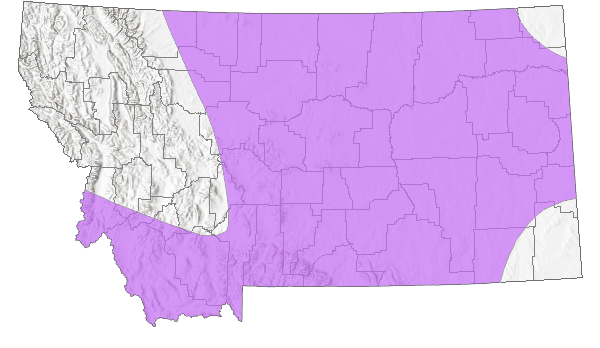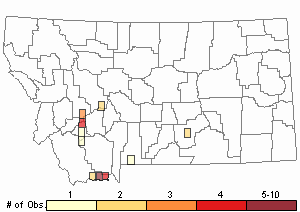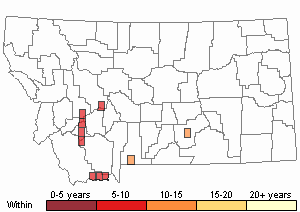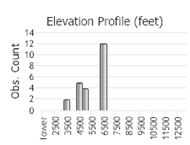View in other NatureServe Network Field Guides
NatureServe
Montana
Utah
Wyoming
Idaho
Wisconsin
British Columbia
South Carolina
Yukon
California
New York
Badlands Tiger Beetle - Cicindela decemnotata
General Description
The following comes from Pearson et al. (2015). The Badlands tiger beetle length is 12-14 mm and mostly found in various shades of metallic green to purplish or reddish-green, sometimes black. Maculations are generally thick, often reduced in number (but complete in the subspecies
C. decemnotata decemnotata in Montana). The middle maculation is a line curving posteriorly at a sharp angle toward midline and does not reach outer edge of elytra. It is entirely metallic blue-green below.
Phenology
Tiger beetle life cycles fit two general categories. “Spring-fall” beetles emerge as adults in late summer and fall, then overwinter in burrows before emerging again in spring when mature and ready to mate and lay eggs. This life cycle may take 1-4 years. “Summer” beetles emerge as adults in early summer, then mate and lay eggs before dying. This life cycle may take 1-2 years, possibly longer depending on latitude and elevation (Knisley and Schultz 1997, Leonard and Bell 1999). Adults of Cicindela decemnotata across its range are active from mid-March to July and again in early September to mid-October and at higher elevations from late June to late August (Larochelle and Larivière 2001, Pearson et al. 2015). In Montana, generally early April to June and late August to September (Knisley et al. 2012, Nate Kohler personal communication), May to early July and September to early October in the Centennial Valley (2030 m elevation) of Beaverhead County (Hendricks and Roedel 2001, Hendricks and Lesica 2007, Winton 2010).
Diagnostic Characteristics
The following is taken largely from Pearson et al. (2015). Anterior maculations are two dots projecting only slightly toward inner edge of the elytra. Thicker maculations, a middle maculation that does not reach the outer edge of the elytra, the sharp angle at which the middle maculation bends posteriorly with an indistinct foot near the midline, the undersides entirely metallic green without coppery tones on thorax, distinguish this species in Montana from the
Green Claybank Tiger Beetle (
Cicindela denverensis) and
Common Claybank Tiger Beetle (
Cicindela limbalis).
Species Range
Montana Range
Range Descriptions

 Native
Native
Range Comments
The following is taken from Wallis (1961), Acorn (2001), Kritsky and Smith (2005), and Pearson et al. (2015). Ranges from southern Alberta and Saskatchewan to southern Utah and northern New Mexico, and from western North Dakota and Nebraska to southeastern Idaho and northeastern Nevada; also isolated populations in Alaska, Yukon, British Columbia, northern Idaho, and central Washington. Widespread in Montana east of the Continental Divide (Knisley et al. 2012).
Observations in Montana Natural Heritage Program Database
Number of Observations: 30
(Click on the following maps and charts to see full sized version)
Map Help and Descriptions
Relative Density

Recency



 (Observations spanning multiple months or years are excluded from time charts)
(Observations spanning multiple months or years are excluded from time charts)
Migration
This species is non-migratory but capable of dispersal. When wings are fully developed (macropterous), it is a strong flier and fast runner (Larochelle and Larivière 2001).
Habitat
Adult and larval tiger beetle habitat is essentially identical. The larvae live in soil burrows (Knisley and Schultz 1997). Cicindela decemnotata are found in open ground, badlands, stabilized dunes, sparsely vegetated grassland, open pine forest, sagebrush steppe, saline flats, brushy areas with clay, sand, or gravelly soils. Road cuts, dirt paths, livestock paths (Hooper 1969, Acorn 2001, Larochelle and Larivière 2001, Kritsky and Smith 2005, Hendricks and Lesica 2007, and Pearson et al. 2015).
Food Habits
Larval and adult tiger beetles are predaceous. In general, both feed considerably on ants (Wallis 1961, and Knisley and Schultz 1997). Diet is unreported for Cicindela decemnotata but probably mostly small insects and spiders.
Ecology
Larval tiger beetles live in burrows and molt through three instars to pupation. Adults make shallow burrows in soil for overnight protection, deeper burrows for overwintering. Adults are sensitive to heat and light and most active during sunny conditions. Excessive heat during midday on sunny days drives adults to seek shelter among vegetation or in burrows (Wallis 1961, Knisley and Schultz 1997).
Cicindela decemnotata has a wide range of ecological tolerance (eurytopic). Diurnal, solitary; often sunning on warm soil, attracted to night lights. Predators not reported but likely include robber flies. Escapes by flying quickly and seeking cover in vegetation rather than alighting in open ground. Wary and difficult to approach. Associated tiger beetle species include
Cow Path Tiger Beetle (
C. purperea),
Boreal Long-lipped Tiger Beetle (
C. longilabris) and
Big Sand Tiger Beetle (
C. Formosa) (Larochelle and Larivière 2001, Hendricks and Lesica 2007) and likely includes others (Kritsky and Smith 2005). Apparently occurs in patchy colonies (Pearson et al. 2015).
Reproductive Characteristics
Mating is reported May to June, duration brief (Larochelle and Larivière 2001). In Montana late May to early July (Hendricks and Lesica 2007). Larvae take two years to develop to adults but possibly three years at higher elevations and latitudes (Pearson et al. 2015). Adults emerge in fall and then overwinter (Acorn 2001).
Management
This species is not considered rare or in need of special conservation management (Knisley et al. 2014). Some colonies (particularly the larval burrows) could be impacted by trampling through livestock overgrazing, but grazing at appropriate times and stocking levels could also be beneficial by keeping vegetation cover more open (Knisley 2011). Prescribed fire may have a negative impact on abundance for the first year post-burn (Winton 2010).
References
- Literature Cited AboveLegend:
 View Online Publication
View Online Publication Acorn, J. 2001. Tiger beetles of Alberta: killers on the clay, stalkers on the sand. The University of Alberta Press, Edmonton, Alberta. 120 p.
Acorn, J. 2001. Tiger beetles of Alberta: killers on the clay, stalkers on the sand. The University of Alberta Press, Edmonton, Alberta. 120 p. Hendricks, P. and M. Roedel. 2001. A faunal survey of the Centennial Valley Sandhills, Beaverhead County, Montana. Report to the U.S. Bureau of Land Management and U.S. Fish and Wildlife Service. Montana Natural Heritage Program, Helena, MT. 44 p.
Hendricks, P. and M. Roedel. 2001. A faunal survey of the Centennial Valley Sandhills, Beaverhead County, Montana. Report to the U.S. Bureau of Land Management and U.S. Fish and Wildlife Service. Montana Natural Heritage Program, Helena, MT. 44 p. Hendricks, P.D. and P. Lesica. 2007. A disjunct population of Cicindela formosa (Say) in southwestern Montana, U.S.A. (Coleoptera: Cicindelidae). Cicindela. 39:53-58.
Hendricks, P.D. and P. Lesica. 2007. A disjunct population of Cicindela formosa (Say) in southwestern Montana, U.S.A. (Coleoptera: Cicindelidae). Cicindela. 39:53-58. Hooper, R.R. 1969. A review of Saskatchewan tiger beetles. Cicindela 1(4):1-5.
Hooper, R.R. 1969. A review of Saskatchewan tiger beetles. Cicindela 1(4):1-5. Knisley, C.B. 2011. Anthropogenic disturbances and rare tiger beetle habitats: benefits, risks, and implications for conservation. Terrestrial Arthropod Reviews 4:41-61.
Knisley, C.B. 2011. Anthropogenic disturbances and rare tiger beetle habitats: benefits, risks, and implications for conservation. Terrestrial Arthropod Reviews 4:41-61. Knisley, C.B., and T.D. Schultz. 1997. The biology of tiger beetles and a guide to the species of the south Atlantic states. Virginia Museum of Natural History Special Publication Number 5. 210 p.
Knisley, C.B., and T.D. Schultz. 1997. The biology of tiger beetles and a guide to the species of the south Atlantic states. Virginia Museum of Natural History Special Publication Number 5. 210 p. Knisley, C.B., M. Kippenhan, and D. Brzoska. 2014. Conservation status of United States tiger beetles. Terrestrial Arthropod Reviews 7:93-145.
Knisley, C.B., M. Kippenhan, and D. Brzoska. 2014. Conservation status of United States tiger beetles. Terrestrial Arthropod Reviews 7:93-145. Knisley, C.B., M.R. Woodcock, and M.G. Kippenhan. 2012. A morphological and mtDNA analysis of the badlands tiger beetle, Cicindela (s. str.) decemnotata Say, 1817 (Coleoptera: Carabidae: Cicindelinae) with the description of three new subspecies. Insecta Mundi 0214:1-49.
Knisley, C.B., M.R. Woodcock, and M.G. Kippenhan. 2012. A morphological and mtDNA analysis of the badlands tiger beetle, Cicindela (s. str.) decemnotata Say, 1817 (Coleoptera: Carabidae: Cicindelinae) with the description of three new subspecies. Insecta Mundi 0214:1-49. Kohler, Nathan S. Excel spreadsheets of tiger beetle observations. 6 August 2022.
Kohler, Nathan S. Excel spreadsheets of tiger beetle observations. 6 August 2022. Kritsky, G. and J. Smith. 2005. Teddy's tigers: the Cicindelidae (Coleoptera) of Theodore Roosevelt National Park, North Dakota. Cicindela 37(1-2):1-16
Kritsky, G. and J. Smith. 2005. Teddy's tigers: the Cicindelidae (Coleoptera) of Theodore Roosevelt National Park, North Dakota. Cicindela 37(1-2):1-16 Larochelle, A and M Lariviere. 2001. Natural history of the tiger beetles of North America north of Mexico. Cicindela. 33:41-162.
Larochelle, A and M Lariviere. 2001. Natural history of the tiger beetles of North America north of Mexico. Cicindela. 33:41-162. Leonard, Jonathan G. and Ross T. Bell, 1999. Northeastern Tiger Beetles: a field guide to tiger beetles of New England and eastern Canada. Boca Raton, FL: CRC Press. 176 p.
Leonard, Jonathan G. and Ross T. Bell, 1999. Northeastern Tiger Beetles: a field guide to tiger beetles of New England and eastern Canada. Boca Raton, FL: CRC Press. 176 p. Pearson, D.L., C.B. Knisley, D.P. Duran, and C.J. Kazilek. 2015. A field guide to the tiger beetles of the United States and Canada, second edition. New York, NY: Oxford University Press. 251 p.
Pearson, D.L., C.B. Knisley, D.P. Duran, and C.J. Kazilek. 2015. A field guide to the tiger beetles of the United States and Canada, second edition. New York, NY: Oxford University Press. 251 p. Wallis, J.B. 1961. The Cicindelidae of Canada. Toronto, Ontario, Canada: University of Toronto Press. 74 p.
Wallis, J.B. 1961. The Cicindelidae of Canada. Toronto, Ontario, Canada: University of Toronto Press. 74 p. Winton, R.C. 2010. The effects of succession and disturbance on Coleopteran abundance and diversity in the Centennial Sandhills. M.Sc. Thesis. Montana State University. Bozeman, MT. 77pp + Appendices.
Winton, R.C. 2010. The effects of succession and disturbance on Coleopteran abundance and diversity in the Centennial Sandhills. M.Sc. Thesis. Montana State University. Bozeman, MT. 77pp + Appendices.
- Additional ReferencesLegend:
 View Online Publication
View Online Publication
Do you know of a citation we're missing? Bousquet, Yves. 2012. Catalogue of Geadephaga (Coleoptera; Adephaga) of America north of Mexico. ZooKeys. 245:1-1722.
Bousquet, Yves. 2012. Catalogue of Geadephaga (Coleoptera; Adephaga) of America north of Mexico. ZooKeys. 245:1-1722. Pearson, D.L., C.B. Knisley, and C.J. Kazilek. 2006. A field guide to the tiger beetles of the United States and Canada: identification, natural history, and distribution of the Cicindelidae. Oxford University Press, New York, New York. 227 pp.
Pearson, D.L., C.B. Knisley, and C.J. Kazilek. 2006. A field guide to the tiger beetles of the United States and Canada: identification, natural history, and distribution of the Cicindelidae. Oxford University Press, New York, New York. 227 pp.
- Web Search Engines for Articles on "Badlands Tiger Beetle"
- Additional Sources of Information Related to "Insects"





